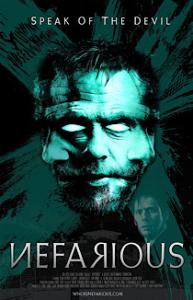“Yes, Virginia, demons are real.” And they are real not only as Francis Church described Santa Claus in his 1897 response to 8-year old Virginia O’Hanlon. In that editorial classic, Church pointed out to the young New York lass how a world without Santa Claus would indeed be a very “dreary” world. Of course, this argument wouldn’t work for demons, or much else for that matter. However, Church also argued that “The most real things in the world are those that neither children nor men can see.” This, on the other hand, is an obvious truth. In a new movie by Chuck Konzelman and Cary Solomon entitled Nefarious, this fundamental truth of both physics and metaphysics is portrayed in a popular and potent format. Indeed, as the movie convinces us, the most real features of our universe are those not directly seen by the naked eye. In this case, the feature in question is the reality of the demonic.
Some Preliminaries Remarks
Before I give my full review of Nefarious, I need to make a few qualifying remarks. First, there will be some spoilers for those who have not yet seen the movie. So, please see the movie before reading this, or, be okay with knowing something of the plot beforehand.
Second, this is one of those films where the movie-goer must ignore the critics’ reviews and give greater weight to the audience rankings. Personally, I usually will not go to a movie, or even rent one, that doesn’t at least have an 80% rating by the critics on Rotten Tomatoes. I tend to agree with the critics, and not the popular audience. Call me a movie snob if you will, but I think critics are critics for good reason. Currently, however, the critics’ reviews of Nefarious average out at 33%, which is both astounding, and, somewhat suspicious.
On this movie, the critics really seem to be driven by some other, ulterior motive than purely aesthetic critique. Perhaps that motive is itself a spiritual one. If it is, which I think it might be, then it would make the unusually low ratings the irony of all ironies. In short, there is no way in hell, and I might mean that literally, that Nefarious does not warrant at least a 70 or 75% rating from a purely aesthetic standpoint. In my view this movie is a solid 3-stars. Unfortunately, it could have possibly been a 4-star film, had the writers not nearly ruined the whole endeavor with an atrocious, out-of-place and genuinely over-the-top ending.
Third, I am mainly going to discuss the theological aspects of the film. Others have done a good job at analyzing its cinematic features. My goal here is to delve more deeply into how the doctrine of demonology is presented in Nefarious: where it is biblical accurate, and why it works or doesn’t work theologically.
On The Aesthetics
It is hard to believe that this movie was written by the same writers of the God’s Not Dead series: one of the most awful series of films ever produced, regardless of “the heart behind them.” I literally walked out of the first two GND films (I still don’t know why I even went to the second one), and walking out of theaters is something I rarely do. That said, there are two scenes in Nefarious where the ham-fisted nature of Konzelman and Solomon’s earlier efforts begins to rear its aesthetically ugly head.
The first, fortunately, is fairly negligible: a short, 30-second speech by an atheist psychiatrist (Jordan Belfi) that sounds far too formulaic and exhaustive to be authentic. However, the superb acting by Sean Patrick Flanery (Nefarious/Edward) saves the scene from devolving into the oh so “on-the-nose” preachiness of prior Konzelman and Solomon iterations. The second scene, the movie’s final scene, is, as alluded to above, almost unforgivable. The last 3+ minutes of the movie caused my jaw to hang so low that my beard began to mop up the remnant popcorn grease on the floor (that image should give you an idea of how unpalatable the final scene is).
However, with the exception of the last few minutes of the film, the writing of Nefarious is quite literary: in both its aesthetic and its instrumental elements. Moreover, as Andrew Klavan points out, the producers demonstrate that with a good script and good acting, a low-budget film can be excellent if it works within its budgetary parameters. Two of Hitchcock’s greatest films, Rope (1948) and Rear Window (1954) both played out entirely in the space of a single room. Thus, Nefarious delivers a solid thriller that doesn’t try to reach beyond its financial limits. Most of the drama plays out in one room, between two men. Little else is called for and nothing else needed. The script and its execution are and remain the focal points throughout the movie.
Beyond the script, which consists primarily of lengthy one-on-one interactions between Edward, the inmate awaiting his death sentence, and the psychiatrist, Dr. Martin, tasked to declare him sane or insane, the acting is top-notch. Flanery should receive an academy award nomination for best actor for playing the demon Nefarious. However, we know Hollywood will never do this. Likely for the same reasons the critics only gave the film an average 33% rating. Still, Flanery should be remembered for delivering one of the most powerful on-screen depictions of evil since Heath Ledger’s Joker (or John Dall’s “Mr. Brandon“). Finally, Jason Head’s cinematography is sophisticated and nuanced, adding all the right value to the script and the actors’ abilities. This movie is a far cry from GND, in almost every way, and that is something to be applauded. There is real progress being made in Christian film making; that is a good thing.
On Nefarious’ Theology
Where the makers of Nefarious truly hit the mark is in their astute, unapologetic presentation of demonology. Again, this articulation of the nature of demons is presented to us with little special effects or CGI frills. The only hint of supernaturalism we see in the entire film is a lightbulb bursting at a convenient moment in the flow of dialogue between Nefarious/Edward and Martin.
Instead of far-fetched, physical prowess, what Flanery portrays with near-perfect execution is not the superhuman power of the demonic but the superhuman knowledge evil spirits possess (Mark 1:34; Luke 4:41; 1 Tim 4:1-3). The true malevolence of the demonic entity is not in its supra-mundane causal powers. As most exorcists will attest, these are incredibly rare occurrences. Instead, the demonic attack comes via its careful examination of the human heart and mind. This is where we are, after all, most vulnerable.
This theological truth is brought out with great force in the film. There are a few lines in Nefarious that will make any epistemologist, Christian or non, sit up in their chair and say “did I hear that right?” In one scene, for example, Nefarious proudly declares that he is “the most rational being” that Martin has ever met. He then goes on to carefully distinguish for his skeptical victim the difference between “knowledge” and “belief.” How many laypeople in the audience will understand the difference between “belief” and “knowledge?” It is hard to say. Yet, it is this kind of subtlety about “the unseen realm” that the writers adroitly work into the script.
But these are matters of tremendous theological importance. Because demons, like other immaterial spirits, are qualitatively different than their embodied counterparts. That difference in nature matters when it comes to other aspects of created existence, like how we know things, or how our soul is oriented morally. Demons, being undeceived deceivers, know things directly. They do not speculate about what is or is not true as we must on account of the uncertain nature of empirical data and the frailty of our own senses.
With regard to moral knowledge, W.T.G. Shedd sheds light on this aspect of the deeper form of evil (and good), namely, its immateriality:
Both holy and sinful affections, in their deeper forms, are mental and disconnected with a physical organism. They have no connection with the sensor’s sensibility.
Shedd, Dogmatic Theology, (514)
This applies directly to angels, good angels or fallen ones, who are not embodied like us:
The seraph who adores and burns does not inherit flesh and blood. His [the angel’s] desires and feelings are purely mental. The fiend, also, is intellectual in his depravity. Lucifer, the ethereal son of the morning, was not tempted to apostasy by any sensuous appetite; and his existing moral condition is mainly intellectual.
Shedd, (514-515)
Paul talks about this form of wickedness in his Letter to the Ephesians, it is a wickedness that exists prior to or apart from any physical body. It can for humans, and will for the fallen angels, lead to eternal damnation:
The wickedness of the fallen angels is denominated by St. Paul ‘spiritual wickedness’ (Ephesians 6:12). ‘Sensibility,’ therefore, is an inadequate term to cover that wide domain which includes the moral desires of the heart and the inclination of the will and which is entirely distinct from the physical and fleshy side of man.
Shedd, (515)
It is in this arena, the immaterial side of man that consists of thoughts, feelings, and his moral will, that we find the battleground of demonic aggression. Nefarious does an excellent job of capturing exactly how demons infiltrate the inner recesses of the human person, of the heart in the biblical sense of the term. Knowledge of the person, especially moral knowledge, is exactly the kind of thing we would expect a demon to mention, if we were to sit down and speak with one. Knowledge of special facts, or arcane knowledge, are merely instrumental to the demon who is out to make (correct) moral judgments about his victim.
Only the ignorant and foolish would think a demon would attack in such flagrant ways as most campy Hollywood horror flicks would have us believe. Perhaps that is itself but another “sleight of hand” by the Father of Lies; a machination meant, to reference another film classic, to convince us he doesn’t exist. The real boldness of Konzelman and Solomon’s latest offering is that we know from the outset it is not just a “psycho-thriller,” like Gregory Hoblit’s Primal Fear. Nefarious certainly is about the psyche, but it is recognizes the reality of more than one kind of psyche, and that is what makes it special.
“Truth” As The Devil’s Greatest Weapon
Konzelman and Solomon’s script does an excellent job of demonstrating the biblical understanding of how the Devil himself works. The Devil, “the Father of Lies,” as Jesus personally describes him (John 8:44), most often attacks humanity with the truth, or, at least, with some truths (Genesis 3:1-7). In the film, Nefarious’ main weapon against Martin, who represents modern, skeptical man, is the employment of straightforward, moral truths. It is in these unapologetic moments of moral declaration, where one can imagine the average critic recoiling in pseudo-intellectual rebellion against the film’s message. We can hear the reviewer muttering under his breath: “These are debatable topics,” or “this is just political propaganda.” Or, more subtly perhaps, willfully separating himself from the content the movie addresses so as to ensure a “dispassionate” review and a clear moral conscience.
There are three, or four such lies the movie exposes by putting their truthful counterparts in Nefarious’ nefarious mouth. The first is, of course, non-belief in God. This is a necessary pre-condition (to steal Jordan Peterson’s overused term) for moral degeneracy. After first mocking Martin’s skepticism, Nefarious then confronts Martin on three moral crimes of our times: euthanasia, abortion and capital punishment.
In the movie, the demon reveals to Martin, who has replaced another psychiatrist who committed suicide (under Nefarious’ influence), that Martin will be responsible for three murders before he leaves the prison that day. Those murders turn out to be Martin’s complicity in the death of his mother, who he had killed through assisted suicide; the death of his baby, whose mother, his girlfriend, he enabled to have an abortion; and, ultimately, of Edward himself, the host body that Nefarious inhabits. The revelation to Martin is not one of facts he was previously unaware of. Instead, what is revealed, are the moral statuses of each of his actions. It is the correct truth value of the moral actions Martin takes that the devil reveals to him. Where Martin once thought there was no guilt, because he believed there was no wrongdoing, he now sees he had everything backwards.
In the scripture, Jesus ascribes only one character feature to Satan in the New Testament. That feature is “liar.” However, Satan is the perfect liar specifically because he knows the truth. At least he knows moral truth. Satan’s deceptions are not errors, they are true deceptions, the exact opposite of what is the case: murder is emancipating, lust is freedom, false worship is life-giving. As such, Nefarious tells Martin only what is true, that he was responsible for three murders. He has, or will, intentionally take three lives: the first two out of convenience, the third out of desperation.
The only difference in this revelation of truth by a demon, as opposed to the same revelation given by the Holy Spirit, is that the demon’s entire will is bent on human destruction. Satan’s desire is to destroy all mankind through his lies (John 8:44), but the lie Satan tells us is that there is no way out of what is genuine guilt– no escape from our very real sins. This all plays out in the mind and heart of man. It is not a physical process, although it does produce physical phenomena. Satan and his demons have no direct power over men, their power is over men’s thoughts, over their minds. The mind is the locus of all human evil, for it is first the mind that either believes truth or suppresses it (Romans 1:18-32).
Christ’s Victory, Satan’s Defeat, Man’s Reward
Throughout the film, Nefarious consistently refers to Jesus as “the Carpenter.” Nefarious’ account of the atonement reflects what theologians have called a “ransom view” of Christ’s sacrifice. According to the ransom view, Christ, in sacrificing Himself on the cross, deceived Satan, who believed he had destroyed the Messiah. However, the one mind that Satan clearly has no access to is the Divine Mind, the Mind of God. Christ’s Resurrection from the dead is the ultimate rebuff of Satan, since God can literally take the most evil thing possible, the murder of that which is perfect, the Son of God, and transform it into the most glorious of all things: Resurrection life and the hope of eternal redemption for all humankind.
While the ransom theory is not central to the atonement, it makes sense to emphasize this aspect given the movie’s theme. The Devil, being uncreative, cannot think in creative terms. Being wholly bent on destruction, Satan cannot see or understand how God can bring life out of death, goodness out of evil (Gen 50:19-21; Job 1 & 2; Acts 2:22-36). This is another reason why the film works, because it gives a reasonable account of why a demon is, in fact, a demon. Fallen angels, in their rejection of God, cannot know God as good. This is brilliantly brought out by evoking Milton’s theodicy in Paradise Lost throughout the film. If one assumes a more libertarian view of human freedom, as the movie tends toward, then Milton’s notion of the fallen angels’ rebellion rings true:
The first sort by their own suggestion fell,
Self-tempted, self-depraved; man falls decieved
By the other first: man therefore shall find grace,
The others none.“Paradise Lost”, 3.129
The eternal destiny of the fallen angels is fixed. It is fixed because they had knowledge of God that men do not, and yet rebelled. Men, on the other hand, can and will find grace. But there is no grace for the Devil or his own. They fell not by deceit, as Adam and Eve did, but by “their own suggestion.” Flanery’s portrayal of this purely volitional hatred of God, and man, is at moments in the film palpable. A short scene just prior to Edward’s (Nefarious’) execution skillfully weaves in this aspect of demonic eschatology: for the demon there is no way out, his destiny is fixed. We really must thank God for this! For human beings, however, grace is available should we choose it: Christ’s victory is man’s reward.
It is in these scenes of intense theological exchange, often read yet rarely dramatized, that Nefarious really hits the mark.

One Criticism of Nefarious
There are, of course, some weak points in Nefarious. I will not reiterate my critique of where it fails aesthetically. My suggestion would be to just walk out as soon as the last scene in the prison, the execution scene, ends. Of course, now that I have built it up, no one will actually do that. However, there is one theological critique that needs to be made, and which is rather substantive.
There is the issue of Edward, the host that Nefarious has inhabited for years. While the movie does hint at how Nefarious gradually entered into Edward through a series of subtle invitations as a child, the degree of possession suggested by the film is problematic. One would have to pose a serious, theological question as to whether demonic possession can affect a human soul to such an extent, that the human soul in question would be inculpable in the criminal actions committed through its body.
If so, the question emerges: is Edward “complicit” in multiple murders or not? The movie almost makes it out to be the case that Edward is so completely manipulated by Nefarious, that Nefarious has absolute control of Edward’s body. When Edward is “allowed” to speak by the demon, he (Edward) appears childlike and innocent. Moreover, Nefarious forces Edward to harm himself, something that is true in reality (Mark 5:1-10), but that makes it difficult to know how to adjudicate the role of Edward in the crimes. This raises all kinds of ontological, moral and legal problems, ones to perhaps explore in a later post. However, if Edward is truly possessed, we would not think there would be such a stark contrast between the two moral agents: Edward and Nefarious. Although, this itself could be one of the demon’s tricks, to make it seem as if Edward is somehow non-compliant in the evil.
Other than this, and the ending, Nefarious is an entertaining, horrifying and theological accurate account of the reality of demonism and the nature of moral evil. The viewer will not be disappointed, unless, of course, you are a close-minded critic, or an Episcopalian priest (mini-spoiler).
Featured image: https://www.whoisnefarious.com/poster


















